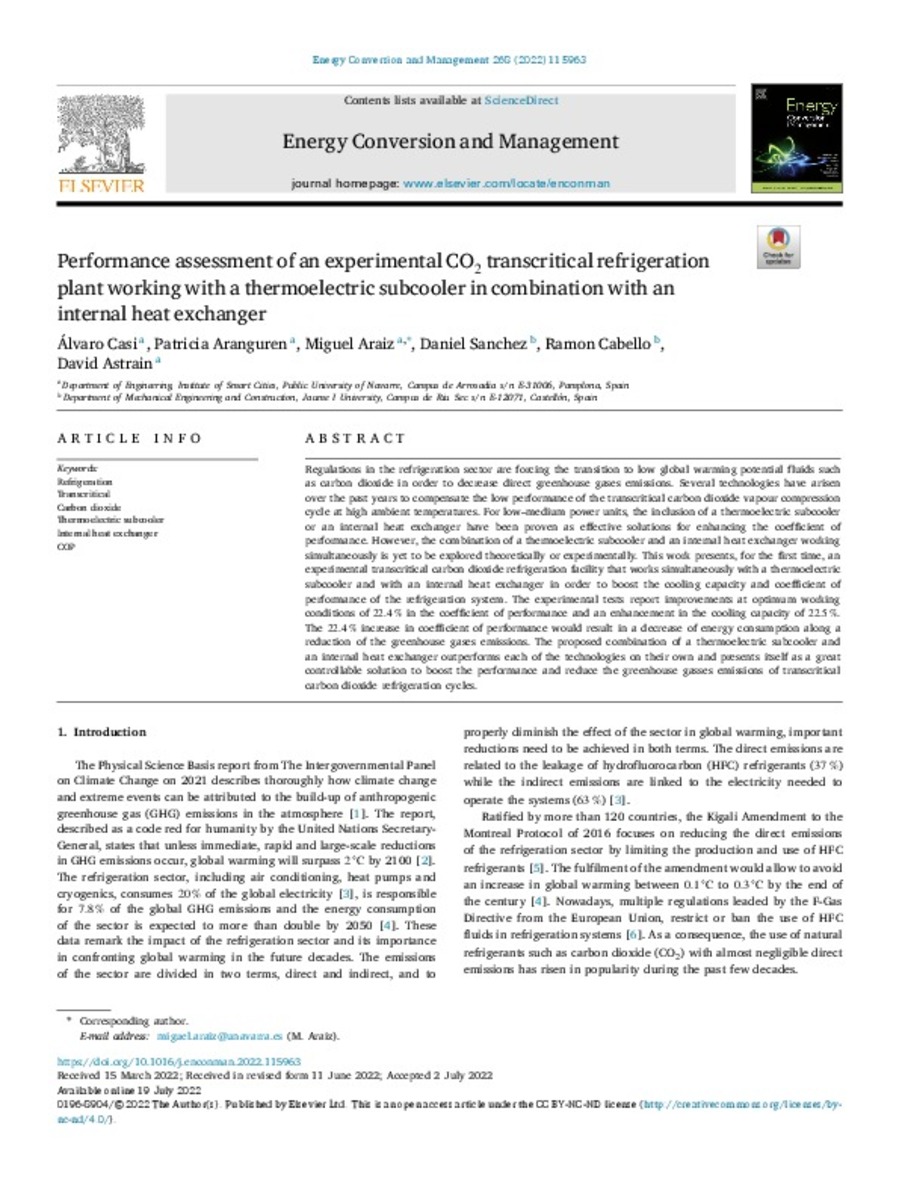Mostrar el registro sencillo del ítem
Performance assessment of an experimental CO2 transcritical refrigeration plant working with a thermoelectric subcooler in combination with an internal heat exchanger
| dc.contributor.author | Casi, Álvaro | |
| dc.contributor.author | Aranguren, Patricia | |
| dc.contributor.author | Araiz, Miguel | |
| dc.contributor.author | Sánchez García-Vacas, Daniel | |
| dc.contributor.author | Cabello López, Ramón | |
| dc.contributor.author | Astrain, David | |
| dc.date.accessioned | 2022-10-05T11:35:00Z | |
| dc.date.available | 2022-10-05T11:35:00Z | |
| dc.date.issued | 2022-07-19 | |
| dc.identifier.citation | CASI, Álvaro, et al. Performance assessment of an experimental CO2 transcritical refrigeration plant working with a thermoelectric subcooler in combination with an internal heat exchanger. Energy Conversion and Management, 2022, vol. 268, p. 115963. | ca_CA |
| dc.identifier.uri | http://hdl.handle.net/10234/200185 | |
| dc.description.abstract | Regulations in the refrigeration sector are forcing the transition to low global warming potential fluids such as carbon dioxide in order to decrease direct greenhouse gases emissions. Several technologies have arisen over the past years to compensate the low performance of the transcritical carbon dioxide vapour compression cycle at high ambient temperatures. For low–medium power units, the inclusion of a thermoelectric subcooler or an internal heat exchanger have been proven as effective solutions for enhancing the coefficient of performance. However, the combination of a thermoelectric subcooler and an internal heat exchanger working simultaneously is yet to be explored theoretically or experimentally. This work presents, for the first time, an experimental transcritical carbon dioxide refrigeration facility that works simultaneously with a thermoelectric subcooler and with an internal heat exchanger in order to boost the cooling capacity and coefficient of performance of the refrigeration system. The experimental tests report improvements at optimum working conditions of 22.4 % in the coefficient of performance and an enhancement in the cooling capacity of 22.5 %. The 22.4 % increase in coefficient of performance would result in a decrease of energy consumption along a reduction of the greenhouse gases emissions. The proposed combination of a thermoelectric subcooler and an internal heat exchanger outperforms each of the technologies on their own and presents itself as a great controllable solution to boost the performance and reduce the greenhouse gasses emissions of transcritical carbon dioxide refrigeration cycles. | ca_CA |
| dc.format.extent | 12 p. | ca_CA |
| dc.format.mimetype | application/pdf | ca_CA |
| dc.language.iso | eng | ca_CA |
| dc.publisher | Elsevier | ca_CA |
| dc.relation | Predoctoral Grants for Phd programms of Interest to Navarra | ca_CA |
| dc.relation | scholarship Fuentes Dutor | ca_CA |
| dc.relation.isPartOf | Energy Conversion and Management, Volume 268, September 2022 | ca_CA |
| dc.rights | © 2022 The Author(s). Published by Elsevier Ltd. | ca_CA |
| dc.rights.uri | http://creativecommons.org/licenses/by-nc-nd/4.0/ | ca_CA |
| dc.subject | Refrigeration | ca_CA |
| dc.subject | Transcritical | ca_CA |
| dc.subject | Carbon dioxide | ca_CA |
| dc.subject | Thermoelectric subcooler | ca_CA |
| dc.subject | Internal heat exchanger | ca_CA |
| dc.subject | COP | ca_CA |
| dc.title | Performance assessment of an experimental CO2 transcritical refrigeration plant working with a thermoelectric subcooler in combination with an internal heat exchanger | ca_CA |
| dc.type | info:eu-repo/semantics/article | ca_CA |
| dc.identifier.doi | https://doi.org/10.1016/j.enconman.2022.115963 | |
| dc.rights.accessRights | info:eu-repo/semantics/openAccess | ca_CA |
| dc.type.version | info:eu-repo/semantics/publishedVersion | ca_CA |
| project.funder.name | Ministerio de Ciencia, Innovación y Universidades (Spain) | ca_CA |
| project.funder.name | European Regional Development Fund. | ca_CA |
| project.funder.name | Government of Navarra. Education Department (Spain) | ca_CA |
| project.funder.name | Universidad Pública de Navarra | ca_CA |
| project.funder.name | Official School of Industrial Engineers of Navarre (Spain) | ca_CA |
| oaire.awardNumber | RTI2018-093501-B-C21 | ca_CA |
| oaire.awardNumber | RTI2018-093501-B-C22 | ca_CA |
Ficheros en el ítem
Este ítem aparece en la(s) siguiente(s) colección(ones)
-
EMC_Articles [810]








